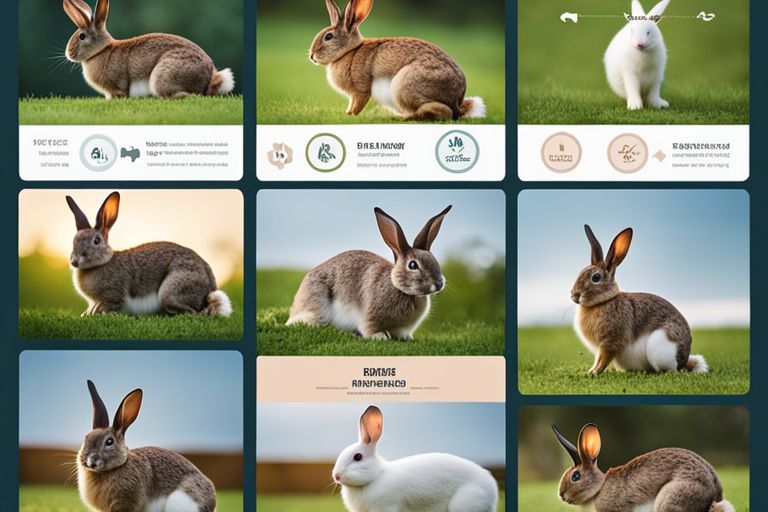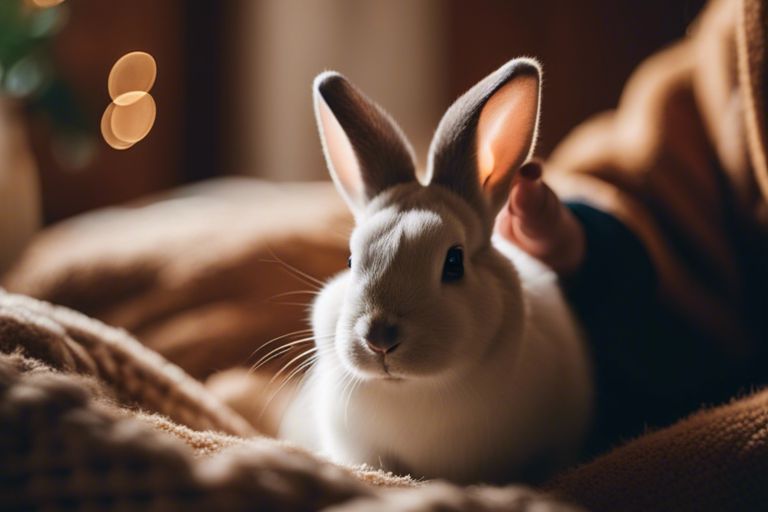This guide aims to provide a thorough understanding of your rabbit’s behavior, allowing you to build a strong and meaningful connection with your furry companion. By delving into the intricate world of rabbit behavior, you will be better equipped to meet your rabbit’s needs and ensure their overall well-being. Understanding your rabbit’s behavior is crucial for maintaining a happy and healthy relationship with these unique and delightful creatures.
Getting to Know Your Rabbit
The key to understanding your rabbit’s behavior lies in getting to know them on a deeper level. By familiarizing yourself with the various aspects of their nature, you can build a stronger bond with your furry companion and ensure their well-being.
Types of Domestic Rabbits
- Rabbit breeds vary in size, color, fur type, and temperament.
- Some common breeds include Holland Lop, Mini Rex, and Lionhead.
- Each breed has its own unique characteristics and care requirements.
The diversity in rabbit breeds allows for a range of personalities and needs among domestic rabbits. Understanding the specific traits of your rabbit’s breed can help you cater to their individual preferences and behaviors effectively.
Factors Affecting Rabbit Behavior
- Environment plays a significant role in shaping a rabbit’s behavior.
- Diet, exercise, and socialization also impact how a rabbit behaves.
Your rabbit’s behavior is influenced by various factors, including their living conditions, daily routine, and interactions with you and other pets. By being aware of these influences, you can create a conducive environment that promotes positive behavior and overall well-being.
For instance, providing your rabbit with ample space to exercise and explore can prevent boredom and encourage natural behaviors. Likewise, offering a balanced diet and social interaction will help keep your rabbit mentally and physically stimulated, reducing the likelihood of behavioral issues.

Interpreting Your Rabbit’s Body Language
Many rabbit owners find themselves puzzled by their pets’ actions, as rabbits have their unique ways of communicating. Understanding your rabbit’s body language can provide valuable insights into their feelings and help you build a stronger bond with your furry friend.
The Language of Ears
Interpreting your rabbit’s body language starts with observing their ears. When a rabbit’s ears are perked up, it usually indicates curiosity or alertness. However, ears flattened against their head may signal fear or aggression. Pay attention to the direction in which their ears are pointing to gauge their mood accurately.
The Tale of Tails and Thumping
Little is known that rabbits communicate through their tails as well. A rabbit’s tail position can convey a lot about their emotions. A relaxed, raised tail signifies a content rabbit, while a tucked or thumping tail may indicate fear, agitation, or discomfort. Take note of these subtle cues to better understand your rabbit’s state of mind.
For instance, rabbits will thump their hind legs on the ground to express displeasure or warning. This behavior is often seen when they feel threatened or sense danger nearby. Understanding these signs can help you create a safe and secure environment for your rabbit.
Postures and What They Mean
Now, let’s investigate into the various postures your rabbit may display and what they signify. A rabbit standing on their hind legs with ears forward is typically showing curiosity or excitement. On the other hand, a rabbit crouching low to the ground may be indicating fear or submission. Being aware of these postures can give you valuable insights into your rabbit’s emotional state.
Tails are vital indicators of a rabbit’s emotions. A tucked tail can signal fear or stress, while a raised tail expresses confidence and comfort. Observing your rabbit’s tail alongside their other body language cues can help you decipher their feelings and respond accordingly.
Behavioral Issues and Solutions
Common Behavioral Problems
Despite their adorable nature, rabbits can exhibit behavioral issues that may challenge even the most experienced rabbit owner. You may encounter problems such as chewing on furniture, digging in unwanted places, aggression towards other pets, or even litter box training regression. Understanding the reasons behind these behaviors is crucial in addressing them effectively.
Step-by-Step Behavior Modification Techniques
You can successfully modify your rabbit’s behavior through positive reinforcement and gentle corrective methods. By implementing step-by-step techniques, you can address common issues like chewing, digging, aggression, or litter box problems. Consistency, patience, and understanding your rabbit’s individual needs are key to reshaping their behavior in a positive way.
On Step-by-Step Behavior Modification Techniques
| Step | Description |
| 1 | Identify the behavior issue and its triggers |
| 2 | Implement changes in the rabbit’s environment to discourage the behavior |
| 3 | Use positive reinforcement techniques like treats and praise to encourage desirable behavior |
| 4 | Be consistent in your approach and patient in seeing results |
The process of behavior modification may take time, so it’s necessary to stay committed to the training plan. By following a structured approach and providing your rabbit with the right environment and stimuli, you can effectively address and correct behavioral issues.
Bonding with Your Rabbit
To truly bond with your rabbit, you need to understand their behavior and build trust. Rabbits are social animals that thrive on companionship and interaction with their human caretakers. Developing a strong bond with your rabbit can lead to a fulfilling and rewarding relationship for both of you.
Tips for Building Trust
- Be patient and gentle in your interactions with your rabbit.
- Offer treats and positive reinforcement to create a positive association with you.
- Spending quality time with your rabbit daily can help build trust and strengthen your bond.
Thou should also respect your rabbit’s boundaries and allow them to approach you on their terms.
Step-by-Step Guide to Socializing Your Rabbit
| Step | Description |
| 1 | Start by sitting near your rabbit’s enclosure and speaking softly to them. |
| 2 | Gradually introduce your hand for your rabbit to sniff and start petting them gently. |
While socializing your rabbit, it’s necessary to read their body language and respond accordingly. Pay attention to your rabbit’s cues to ensure they feel comfortable and safe during the bonding process.
Plus
| Tips | Benefits |
| Regular grooming sessions | Strengthens the bond and promotes trust |
| Interactive playtime | Provides mental stimulation and reinforces the bond |

Communication and Training
After bringing a rabbit into your home, it’s necessary to understand how to effectively communicate with and train them. Rabbits are intelligent animals that can learn basic commands and behaviors through positive reinforcement and patience.
Teaching Basic Commands
Some basic commands you can teach your rabbit include ‘come’, ‘stay’, and ‘up’. Using a clicker or treats can help reinforce the behavior you want to see. Be consistent and patient with your training sessions, keeping them short and positive to avoid overwhelming your rabbit.
Litter Training Your Rabbit
Basic litter training is a crucial aspect of owning a rabbit, as they can be taught to use a litter box just like a cat. Start by placing a litter box in a corner of their enclosure where they typically eliminate. Encourage them to use the box by placing some of their droppings in it.
The key to successful litter training is consistency. Rabbits are creatures of habit, so maintaining a clean litter box and rewarding them when they use it will help reinforce the behavior. Avoid using clay or clumping litters, as they can be harmful if ingested. Opt for a safe litter made of paper or wood shavings instead.

Health and Behavior
Now, understanding your rabbit’s behavior can be crucial in detecting any signs of illness. Rabbits often try to mask their symptoms of sickness, so it is necessary to pay close attention to any changes in behavior that may indicate an underlying health issue.
Recognizing Signs of Illness Through Behavior
To recognize signs of illness through behavior, observe your rabbit’s eating habits, water consumption, activity levels, and social interactions. Any sudden changes in these areas could be a red flag. For example, a normally active rabbit suddenly becoming lethargic or a friendly rabbit becoming aggressive could signal a health problem.
The Impact of Diet on Behavior
Some rabbits’ behaviors can be directly influenced by their diet. A diet lacking in necessary nutrients can lead to behavioral issues such as aggression, excessive grooming, or even depression. Ensuring your rabbit has a balanced diet with ample fresh hay, vegetables, and occasional treats can positively impact their behavior and overall well-being.
Behavioral problems arising from a poor diet can be corrected by making necessary changes to their feeding routine. Consulting with a veterinarian or a rabbit-savvy nutritionist can help you create a diet plan tailored to your rabbit’s specific needs.
Enrichment for Mental and Physical Health
Keep your rabbit’s mental and physical health in top shape by providing enrichment activities that stimulate their natural behaviors. Enrichment is vital for rabbits to prevent boredom, encourage exercise, and promote overall well-being.
Types of Toys and Activities
- Chew toys: Provide a variety of safe chew toys to help wear down your rabbit’s constantly growing teeth.
- Puzzle feeders: These toys not only mentally stimulate your rabbit but also provide a fun way for them to access their daily food.
- Tunnels: Rabbits love to explore and hide, so tunnels are a great way to cater to their instinctive behaviors.
- Cardboard boxes: Simple yet effective, cardboard boxes provide a safe space for rabbits to play, hide, and chew.
- Digging box: Fill a shallow container with safe materials like hay or shredded paper for your rabbit to dig and forage in.
Knowing what types of toys and activities your rabbit enjoys can help tailor their enrichment experiences to their preferences.
Creating a Stimulating Environment
Toys such as tunnels and puzzle feeders can greatly contribute to creating a stimulating environment for your rabbit. These toys encourage physical activity and mental engagement, mimicking their natural behaviors in the wild.
Enrichment is crucial in preventing behavioral issues such as aggression or excessive chewing. By providing a wide range of toys and activities, you can ensure that your rabbit leads a healthy and fulfilling life.
To wrap up
Now that you have learned about the various behaviors of your rabbit, you can better understand and communicate with your furry friend. By recognizing signs of fear, happiness, aggression, or illness, you can provide appropriate care and create a trusting relationship with your rabbit. Remember to always approach interactions with your rabbit calmly and patiently, respecting their boundaries and needs.
Being able to interpret your rabbit’s behavior will not only strengthen your bond with them but also contribute to their overall well-being. By observing their body language, vocalizations, and habits, you can ensure that your rabbit feels safe, loved, and understood. With this comprehensive guide, you are now equipped to navigate the world of your rabbit’s behavior with confidence and compassion.
FAQ
Q: Why is it important to understand your rabbit’s behavior?
A: Understanding your rabbit’s behavior is crucial for building a strong bond with your pet and addressing any potential health or well-being issues early on.
Q: What are some common behaviors exhibited by rabbits?
A: Common rabbit behaviors include thumping, chin rubbing, binkying, and digging. By understanding these behaviors, you can better interpret your rabbit’s needs and emotions.
Q: How can I create a rabbit-friendly environment to support their natural behaviors?
A: To create a rabbit-friendly environment, provide plenty of space to run and hop, hideaways for security, toys for mental stimulation, and a healthy diet to support their well-being.
Q: What does it mean when a rabbit exhibits aggressive behavior?
A: Aggressive behavior in rabbits can be a sign of fear, pain, or territoriality. It is important to address the underlying cause and consult with a veterinarian or animal behaviorist if needed.
Q: How can I bond and communicate effectively with my rabbit?
A: Bonding with your rabbit involves spending quality time together, using positive reinforcement for training, and respecting their boundaries. Effective communication can be achieved through body language observation and gentle interactions.











